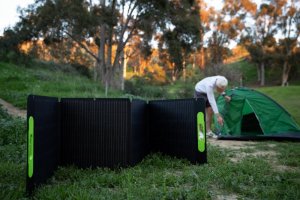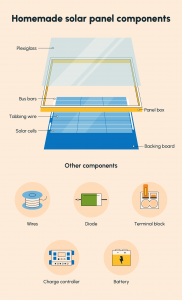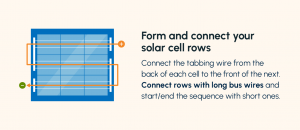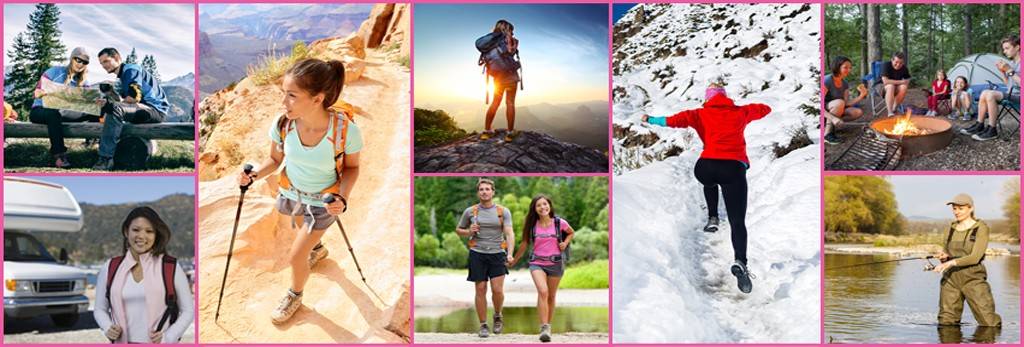
Siege Media’s Jen Pedrozo shares how to set up solar panels for camping without spending a fortune.
Part of the appeal of camping is getting away from it all. Unfortunately, that also means losing access to everyday comforts like electricity. You can always hook up to a generator to run electricity for any lights or appliances you have at your campsite or camper, but those aren’t environmentally friendly and can pose a fire risk. Fortunately, solar panels for camping are a great source of energy.
Solar panels have become more popular among campers, but purchasing a kit can get pricey. Instead, opt to make your own solar panel. Read on to learn more about using solar panels when you camp and how to make your own.
Contents
The Benefits of Using Solar Panels While Camping
Solar panels for camping are a great way to power your campsite while following the camping adage of leaving no trace. Setting up a solar panel system at your campsite has the following benefits:
- Solar energy is clean. Once assembled, solar panels don’t have any negative environmental impacts. Unlike gas generators, they don’t burn fossil fuels or release toxic byproducts into the air. Perhaps most importantly for campers, solar energy is completely silent, so you can enjoy the sounds of nature rather than the roar of your generator’s engine.
- Solar energy is free. Once you buy the solar panel and the battery to store power, you won’t have to pay another cent for solar energy. With a generator, you’d have to keep purchasing gas for your generator or paying hookup and usage fees for a campsite with electricity hookups.
- Solar energy is easy to set up. Using solar energy is easy: just put the solar panel in a spot that gets sun and connect it to your battery for storage.
- Solar energy is portable. Wherever there is sun, you can have power with a solar panel. Want to camp beachside? No problem. Prefer the wilderness in the mountains? Do it. Unlike a generator, you’ll never have to leave your campsite to restock your fuel since the sun never runs out of energy.
- Solar energy is easy to maintain. All you need to do to keep your solar energy system running is clean your solar panel occasionally. No tune-ups or other maintenance required like with a generator.
How To Use Solar Panels While Camping
Before you commit to using solar at your campsite, you need to consider your needs.
- How do you plan to use your solar panel at your campsite? Are you just trying to keep your cell phone charged, or will you be powering a projector for movie night in nature? How much energy you need determines what size solar panel you’ll need.
- Where will you put the solar panel? Look for a space on your campsite that gets the most sun during the day. While a solar panel can still generate energy in partial sunlight, it won’t produce as much as in the sun. Before you head to your campsite, research the amount of sun it receives and check the weather forecast.
- When will you need the energy from your solar panel? Will you just need it during the day, or will you use it to power lights at your campsite? If you plan on using the energy at night, you’ll want to invest in a large enough battery to store the energy for when needed.
Once you purchase (or make your own) solar panels, all you’ll need to do at your campsite is place the solar panels where they’ll get the most sun and connect it to your battery storage. You can even mount them on the roof of your campervan or RV so they’re always harnessing energy.
How To Make Your Own Solar Panel for Your Campsite
While you can purchase solar panel systems for camping, you can build one yourself if you have the right tools and know-how. If you have the tools at your campsite, you can assemble your solar panel there, or create it at home before you leave.
Step 1: Gather the necessary parts and tools
The first thing you need to do is purchase the necessary parts and gather all the tools you need for the job. Buy your solar cells first, as the size of your cells will determine what size panel you need to build.
Necessary parts for the solar panel itself include:
- Solar cells
- A sheet of plexiglass
- Four 1x2s
- A backing board (Choose something non-conducive, like wood, cardboard, glass, or plastic. Wood is preferred since it’s easier to cut and sturdier than the other options.)
- A roll of tabbing wire
- A roll of solder
- A tube of silicone adhesive
- Bus wire
For the battery system, you’ll need the following:
- A diode
- A terminal block
- A charge controller
- A battery
You’ll also need the following tools:
- Soldering iron
- A flux pen
- Wire cutters
- A saw
- Deck screws
- Butt joints
- Screw gun/screwdriver

Step 2: Create the backing board
Lay your solar cells on the backing board in as few rows as possible but don’t attach them to the board yet. There should be a small space between each cell.
Measure an additional two inches of space beyond the ends of your rows, above the top row, and below the bottom row. That’s how large your backing board should be.
Cut the board to the size you measured.
Step 3: Cut your tabbing wire and connect it to the solar cells
Your tabbing wire connects each solar cell to another. Cut the wire to lengths twice the size of the contract pads on the solar cells. You’ll need two of these per cell.
Use a flux pen to flux the path of the wire to prevent oxidation while you solder the wire to the cells. Then use your solder iron and solder to connect two pieces of tabbing wire to each cell. Half of each wire should extend from one side of the cell. You’ll use that later to connect the cell to the next one.

Step 4: Connect your solar cells
Use a dot of silicone adhesive to connect the back of your solar cells to the backing board. Keep the tabbing wire straight to connect all the cells in the row.
Each row should alternate wiring directions. So if the wires in the first row connect a cell to the one to the right of it, then wires in the next row should connect each cell to the one to the left of it.
Then solder the ends of the tabbing wire to leads on the top of the next solar cell. Remember to use the flux pen to prep the area before soldering.
Solder tabbing wire to the leads on top of the first solar cell in your row so it points off the board. Connect these two pieces of tabbing wire to bus wire that is an inch longer than the space between contact pads on the cells. This is the positive end of your solar panel.
At the end of the row, attach a longer piece of bus wire to connect the reading wire of the first row with the tabbing wire in the row below it. Add two pieces of additional tabbing wire to the last cell in this row, and connect it to the row below it with bus wire. Repeat as needed until all the wires are connected.
The last solar panel in the last row should connect to another short piece of bus wire, just like the positive end. This is the negative end of your solar panel.
Step 4: Construct the panel box
You’ll need to create the panel box to protect all the cells you just wired together from the elements.
Measure and cut your 1×2 planks to fit the backing board. Using deck screws, butt joints, and a screw gun, attach the cut 1x2s to each other to construct a frame.
Drill holes in the 1x2s where you have the two shorter pieces of bus wire. The holes should be slightly larger than the diameter of the bus wire.
Finally, glue the backing board to the finished box. Be careful not to disturb any of the cells or other components.
Step 5: Wire your panel
Once the box is constructed, it’s time to assemble the wiring so the energy from the solar panels can be used.
Start by connecting your panel to a diode, which directs the current from the solar panel to the battery. You’ll need to solder one end of a wire to the bus wire on the negative end of your solar panel and connect the other end of the diode.
Solder another wire (use a different color) to the bus wire on the positive end of your solar panel.
Install a terminal block to the side of your solar panel box. Run both wires from your solar panel’s positive and negative ends through the terminal block.
Connect your terminal block to a charge controller to regulate the electrical current to prevent overcharging your battery.
Finally, connect the charge controller to your battery.
Step 6: Seal the panel box
Glue 1×1 blocks in each corner of the panel box. Be careful not to disturb any of the solar cells.
Cut a sheet of plexiglass to the size of your solar panel box. Then place the plexiglass sheet on the four blocks. Screw the plexiglass to the blocks. Seal the edges of the plexiglass to the walls of the solar panel with a silicone sealant.
You’re ready to start harnessing solar energy to power your campsite!
Now check out Solartap’s full infographic to learn more about building your own solar panel.
Have you set up Solar Panels for Camping?
If not, have you thought about trying this for your next trip? Perhaps you are experienced with solar panels and their use in the great outdoors. Please do share your thoughts below.
Jen Pedrozo is a content writer from Columbus, Ohio. She enjoys developing the best content for her clients and learning everything she can about new topics. When she’s not writing, Jen can be found working on her novel, cheering on the Columbus Blue Jackets with her husband, or reading a good book on the couch with her dog.


I just read your blog on solar power and was really intrigued with the info you gave. I’m going to try solar on my next hiking adventure!! Thanks for the great information!!
I love using solar chargers when i’m on my multiday hikes and camping, they are brilliant. Though I love to be cut off from the world, my phone is a lifeline when coming back especially if we are late or early and need to change plans so having some battery left is essential. I didn’t realise how easy it is to make a solar panel. I am definitely saving this for later and going to give this a go over the summer.
So far, I have not used solar panels on my camping trips. But after reading your article, I will gladly try to use them on my next trip, because it would solve the electricity problem in more remote places. It’s great that you give so many details about the construction of the panels and how to use them. I like this step-by-step instruction with all the components and materials. It’s great that you also mention their many advantages for the environment.
That sounds like a wonderful idea and useful as well. Definitely a great guide on making one when we plan for camping soon.
I never realized that making these panels could be a DIY. Your detailed steps definitely make it easier for one to even attempt it. And yes, I am all for it. For one it is definitely a greener way of life and two – the whole DIY has an appeal to it. Bookmarking it
Every time we go camping, we should think about the impact our actions will have on the environment. I’m glad to see that as we become more modern, the equipment we bring outside is also getting better. Despite their high cost, solar panels have many advantages. I appreciate your idea and would like to learn more about how to make one.
I would be one of those people that would want to take solar panels with me for camping. Having a little power at all times would make me feel a little more connected. Although I am not sure about making one myself. Size and weight would be one of my key considerations if I tried to buy one that was just right for my needs.
I wouldn’t have thought I could just build my own solar panels for camping, but you did a great job of illustrating and carefully detailing what is needed. A good friend of mine built a solar oven and baked chocolate chip cookies in it when she camped, and I thought that was super clever! Solar power certainly comes in handy when camping!
Oh wow! This is such a great thing to take camping. I never even thought about having something to harness solar power to make camping easier. So smart!
That’s awesome, I will keep this in case we will need to do it. It’s easy to follow as well. Thank you for sharing!
I see solar panels more and more on houses and it’s gotten me curious. I love the idea of having them for camping. So cool.
Wow, I never thought about using solar panels for camping before. This is such a great way to be eco-friendly while still having access to electricity while out in nature. Making your own solar panel sounds like a fun DIY project too! Thanks for sharing this helpful and informative article.
Hhhhmmmm….I am not so big on camping but this is something I’ve wanted to try out, when I am out of my home (my comfort zone). It’s gotten to a point where I want to build one myself.
That’s impressive! I have to admit we bought our own (100w) and it’s just fine to power two laptops non-stop in the van when it’s sunny. I didn’t know you could build your own!
Solar when camping…what a great idea. I never would have thought about it because we never really use anything electric when camping but this is a good resource to remember.
I found your article on solar panels for camping to be incredibly informative and well-written. The step-by-step guide and product recommendations were especially helpful. Thanks for sharing!
I love the idea of having solar panels while I am camping. With my job I need to stay in touch even while on vacation. Having panels such as these will make charging phones and tablets a breeze (and won’t have to run my car for charging!).
I never thought that you could make your own solar panels rather than buy them ready made. I would definitely be interested in this, as a nice diy project but also to take with me next time I go camping, in May. Last time it was a real struggle to keep my devices connected, with only one power bank available.
Now, thats my camping adventure plan sorted. Solar power? I don’t think I will be going back home for a while.
The benefits of using solar panels for camping are numerous, and I appreciate how the author has highlighted each one of them. The fact that solar panels are environmentally friendly, free, portable, easy to maintain, and easy to set up has convinced me that using solar energy for camping is the way to go. I also appreciate the author’s detailed instructions on how to make your own solar panel and the necessary parts and tools needed for the job.
I have never set up anything electrical in mylife. Your diagram makes it seem so easy. And in India, there’s so much sunlight that these panels would be so useful. Glad to have read this post.
It is really nice to have the option of solar power to power up your camp. Such a great resource for camping.
You make it look so easy to make your own. I may have to work on this.
This is so cool! I have always loved camping, but never went camping ”for real”. I’ve always done backyard camping with the kids. Or even as a kid. And we’d always come back inside in the middle of the night, haha. I am all for a more eco-friendly lifestyle, and we are actually planning on getting solar for our home. I never through of getting solar while camping. People always look at camping sites with electricity. This makes things so much easier. Thanks for sharing!
What a fantastic idea to have solar panels whilst camping. Such a great way to make use of nature and help the environment.
Great and helpful post to campers! Thank you for the great suggestion to add Solar Panels. It’s great that it’s Eco-Friendly, too!
My family is full of campers from two generations back. All of the grown cousins have the campers you pull or drive. This is a great thing for everyone. And my first to hear of it@
Solar panels for camping?! Now this is the kind of camping I could get into.